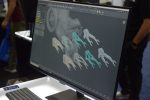
nTop to boost CFD speed and engineering efficiency with its latest acquisition
3dprintingindustry.com
Software company nTop has acquired German firm cloudfluid, a specialist in computational fluid dynamics (CFD) simulations.With this move, the software company aims to simplify how engineers analyze fluid behavior, addressing one of CFDs long-standing challenges, lengthy simulation times that slow down design iterations. As a result, the acquisition integrates cloudfluids GPU-native solver into nTops computational design platform, providing engineers with faster, more efficient CFD analysis.On another note, nTop has also announced plans to host its second annual Computational Design Summit in Los Angeles this June.We are hyper-focused on building software that helps engineers go from requirements to design as fast as the latest computing processors allowthats the power of computational design, said Brad Rothenberg, CEO of nTop.nTop software on display at RAPID + TCT 2024. Photo via nTop on LinkedIn.Enhancing CFD simulations with faster processingAnyone whos worked with CFD knows that running a simulation can be a slow, complicated process.Traditional CFD software relies on CPU-based solvers, which process simulations sequentially, often leading to long wait times, especially when dealing with complex aerodynamic or thermal analyses. Cloudfluids GPU-native solver runs calculations in parallel, significantly speeding up simulations and making fluid dynamics analysis more practical for rapid design workflows.Another key advantage is that cloudfluid removes the need for complex meshing. Standard CFD tools require engineers to manually create detailed conformal meshes, a process that is both time-consuming and difficult to refine.Cloudfluids solver eliminates that step while maintaining accuracy, allowing engineers to focus on testing and optimizing their designs rather than spending hours preparing simulations.By integrating cloudfluids fast CFD solver with nTops implicit geometry kernel, engineers working in aerospace, defense, and turbomachinery can now test and refine designs faster. The ability to analyze fluid dynamics in near real-time makes it easier to explore different configurations, fine-tune propulsion systems, and improve thermal management, all without slowing down development cycles.Beyond performance improvements, this integration also supports machine learning applications in engineering.High-quality simulation data is essential for predictive modeling in digital twins and design optimization, yet generating reliable datasets has traditionally been costly and time-intensive. Cloudfluids capabilities enable engineers to produce these datasets more efficiently, making AI-driven decision-making more accessible for manufacturers and designers.This acquisition follows previous collaborations in the high-performance computing space. Prior to this, nTop collaborated with GPU manufacturer Nvidia to integrate its computational design software with OptiX ray tracing and Omniverse, bringing faster visualization and simulation capabilities to engineering workflows.Backed by an investment from NVentures, Nvidias venture capital arm, this alliance is expected to help engineering teams iterate designs more efficiently and reduce product development timelines. Integrating Nvidias GPU-accelerated rendering technology allows nTop 5 users to generate highly detailed renderings and interact with live digital twins without the need for meshing.Engine part simulation in nTop 5. Image via nTop.Expanding engineering software capabilitiesSimilar advancements have emerged in the design software landscape, with various companies developing tools to enhance engineering workflows.Last year, Cognitive Design Systems (CDS) launched Cognitive Design, a software platform designed to help engineers optimize designs while ensuring manufacturability. According to the company, traditional CAD workflows often require switching between multiple tools, leading to time-consuming iterations and increased chances of errors.To tackle these challenges, Cognitive Design combines optimization and manufacturability into one platform, allowing engineers to refine complex geometries, reduce weight, and make real-time adjustments using simulation-driven parametric design and topological optimization. The software also includes manufacturing analysis tools to catch potential flaws early, ensuring designs can be efficiently produced.Elsewhere, engineering software developer Hyperganic launched Hyperganic Core 3, the latest version of its AI-driven algorithmic design software in 2022. Backed by a $7.8 million funding round, the platform allows engineers to design 3D printable parts using algorithmic models, offering an alternative to traditional component design.Additionally, the software enables streamlined workflows in industries like aerospace, enabling complex geometries to be generated in minutes while maintaining performance optimization.What3D printing trendsshould you watch out for in 2025?How is thefuture of 3D printingshaping up?To stay up to date with the latest 3D printing news, dont forget to subscribe to the 3D Printing Industry newsletter or follow us on Twitter, or like our page on Facebook.While youre here, why not subscribe to our Youtube channel? Featuring discussion, debriefs, video shorts, and webinar replays.Featured image shows nTop software on display at RAPID + TCT 2024. Photo via nTop on LinkedIn.
0 Comments
·0 Shares
·51 Views


